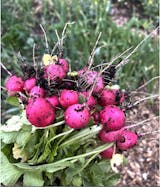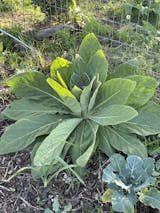I am often asked about my favorite crops to grow so I thought I'd share. This is the print version from my video Top 10 Homestead Crops
Choosing my favorites is no easy task but I've included a few specific varieties throughout this article that might help you choose. If you have additional questions I'm happy to help!

Cold hardiness and nutrient-rich qualities are why cabbage makes this list. It can stay in the garden late into fall and store in a root cellar or cold greenhouse. Sauerkraut, a fermented food rich in vitamins and probiotics, is a traditional means of preserving cabbage, and your kraut can keep in a crock for months.
Pictured is Pak Choy Cabbage (also called bok choy and pok choy). This is a fantastic, fast-growing variety of Chinese cabbage.
Kale is a superfood that keeps on giving! When growing Kale, you harvest the outer leaves instead of pulling up the whole plant. This allows for multiple harvests of nutrient-dense food.
Lacinato Kale is a good heat-tolerant variety if you live in warmer climates
Collards are cool weather crops but some do very well in warmer climates. Morris Heading and Georgia Green both do well in warmer growing areas.
Greens don't last very long once harvested so you'll need to use them up or preserve them. 2 simple ways to preserve greens are freezing and dehydrating.
Winter squash, rich in fiber and vitamins A and C. Grow ‘Waltham Butternut’ for a pest-resistant, HUGE performer in the garden. Pumpkin and Acorn squash are also homestead favorites and they store very well.
HUBBARB BLUE reaches 16 to 20 pounds. It is also a "trap crop" for companion planting so Hubbard Blue is a must-have in our garden
If stored properly, winter squash and pumpkin can last a few months after harvest making this an excellent homestead crop.
- Staples Crops: Dry Beans & Green Beans
Beans are most definitely a homestead favorite. From our article Feeding a Family from the garden, it is recommended to plant 10-20 plants per person to feed for a year. If you're just looking to add to your food preps, 5 plants or more per person would work
Dry beans, or legumes, are a homestead favorite as they store very well without needed to can them.
Green Beans are easy to grow and can or freeze. If you have a smaller garden space, planting pole beans are an excellent option as they grow UP.
Providing homegrown food for your table is such an amazing thing. Heirloom Corn can be used fresh or dried for future use. Animals can be fed from stored corn making Heirloom Corn one of our top 10.
As we mentioned in our video Heirloom Corn varieties at Mary's Heirloom Seeds, there are 6 types of corn: Sweet, Popcorn, flint, flour, dent and waxy.
Flint corn is suited to cooler, wetter climates and is the most difficult to grind.
Flour corn, grown by American Indians in the Southwest, is the easiest to grind.
Dent corn is characterized by the dent in the top of each kernel.
Common field corn is dent corn.
Popcorn is exactly as the name implies. It is used dried for popping.
Sweet corn does not store as well so it should be consumed or preserved after harvest.
- ROOT CROPS: Garlic & Potatoes
I know I mention a few different root crops for homesteading but Garlic and Potatoes are in a category together as they store very well if properly cured. "Seed potatoes" and "seed garlic" is available from most seed companies only seasonally. You can use store bought but you might be exposing your garden to soil born diseases.
We have 2 videos about garlic planting:
Tomatoes can be dried, frozen or canned. They can be made into soups, sauces, pastes and more. They then become the base ingredient in hundreds of kitchen recipes. Tomatoes are one of the easiest veggies to can because they are a high acid veggie and as such, they can be water bath canned instead of needing a pressure canner.
Yellow Pear tomato is a sweet and juicy snack I like to eat right out in the garden. San Marzano tomato has been a hearty producer for making sauce. Cherokee Purple Tomato is still my all time favorite for slicers but Emerald Green is a close second!
Fast growing, fast maturing and a double duty crop because you eat the root and greens. Easy to pickle and delicious raw. Radish can also be roasted just like mini potatoes. French Breakfast Radish is a more mild variety. German Giant Radish can be eaten small or large. Japanese Daikon is a nice, spicy variety but it takes a couple weeks longer to mature.
Fast growing, fast maturing and a double duty crop because you eat the root and greens of beets. Depending on your growing region, some gardeners can grow beets year-round.
Detroit Dark Red is definitely a favorite because it's so pest resistant. Red Mammoth Mangel deserves a mention because it can grow 20 POUNDS, making it great to feed livestock
- Wheat for those of you not gluten sensitive. Wheat is used to make so many food items such as bread, pasta and pastries.
We carry Einkorn Wheat berries, which is an ancient grain. Some people with gluten sensitivity have had success using Einkorn instead.
BUT...I would say SUNFLOWERS instead on our homestead. We avoid wheat. Sunflowers produce seeds to feed us and our chickens. They also produce A LOT of seeds to grow more. Sunflowers also attract pollinators to our garden to help us grow the BEST garden ever!
Pretty much grow your own pharmacy if you know what to grow and how to dry it. We offer a few seed combo packs like the "In the Kitchen" Herb Garden Kit to help you grow a small herb garden. For your own home apothecary, we have quite a few options. CLICK HERE to see our herb seed combo packs
If I had to pick 3 specific varieties to grow?
TOP 3 Varieties:
Blue Lake Bush Beans, Hubbard Blue Squash and Cherokee Purple Tomato

Happy Planting!
Sign up for our E-Newsletter


















21 comments
Thank you again for being part of the New Leaf giveaway. I’m excited to hear who won, it is sure to be a blessing!
Hard to pick a favorite but I do like winter squash.
My favorite crop would be sweet corn or tomatoes for eating, but I have an obsession with sunflowers! 🌻😍 There are so beautiful
I love the green beans!
I love planting squash and radishes. They are so satisfying and the first plants that I had true success with.
I love growing tomatoes and herbs.😊
Thank you for being part of the New Leaf Giveaway and for all the opportunities to enter the giveaway!
Oh how to choose a favorite?! Definitely between cabbage/collards/kale and tomatoes.
My favorite homestead crop is tomatoes!
Thanks for the awesome giveaway!
Green Beans are our favorite to grow each year but we want to concentrate more on herbs this next year.
Sweet corn is my favorite, but it’s been a challenge in Miami with the insects.
I can’t pick a favorite. But I had tremendous success with green beans last year. 😊this is an amazingly awesome opportunity!
I can’t pick a favorite. But I had tremendous success with green beans last year. 😊this is an amazingly awesome opportunity!
For homesteading purposes, I agree with your selection of staple crops. But… no homestead is complete without perennial crops. In my opinion, the “must haves” are asparagus, berries such as blackberries, raspberries, goji berries, elderberries, & don’t forget such favorites as rhubarb, horseradish, jicama, sunchokes & whatever fruit trees you like. Of course, you’ll need a pollinator friendly habitat & food sources. Combining perennials with biennials & annuals means there’s always something to graze on year round. To me that represents the concept of homesteading.
I’d like to start more of these. So far I’ve only tried tomatoes and sunflowers.
I have been searching for good quality heirloom seeds so that I can start harvesting seeds from my garden every year!